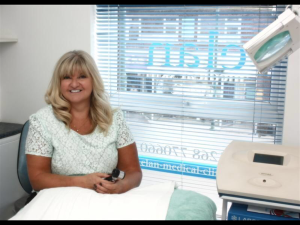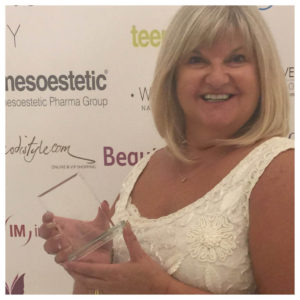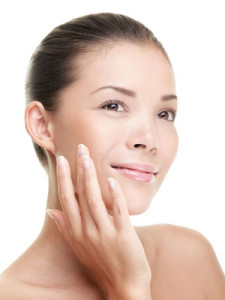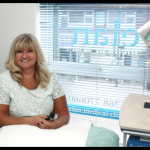Rosacea is a chronic but treatable condition that primarily affects the central face, and is often characterized by flare-ups and remissions. Although rosacea may develop in many ways and at any age, patient surveys indicate that it typically begins any time after age 30 as flushing or redness on the cheeks, nose, chin or forehead that may come and go. Studies have shown that over time the redness tends to become ruddier and more persistent, and visible blood vessels may appear. Left untreated, inflammatory bumps and pimples often develop, and in severe cases — particularly in men — the nose may grow swollen and bumpy from excess tissue. In as many as 50 percent of patients the eyes are also affected, feeling irritated and appearing watery or bloodshot.

Rosacea can affect women in their mid-thirties.
Although rosacea can affect all segments of the population and all skin types, individuals with fair skin who tend to flush or blush easily are believed to be at greatest risk. The disorder is more frequently diagnosed in women, but tends to be more severe in men. There is also evidence that rosacea may tend to run in families, and may be especially prevalent in people of northern or eastern European descent.
What causes rosacea?
Although the exact cause of rosacea is unknown, various theories about the disorder’s origin have evolved over the years. These have often related to its primary outward signs and symptoms: flushing and redness, bumps and pimples, and the small visible blood vessels called telangiectasia. The range of possible causes has included defects in the immune system, nervous system and facial blood vessels, and the presence of microbes and Demodex mites. Anecdotal evidence also suggests that a susceptibility to developing the disorder may be inherited, and genetic studies are now underway.
Microscopic Demodex mites are a natural part of the human microbiome — the ecological community of microorganisms that live within and on the body. Two species of Demodex are found in humans. Demodex folliculorum live in hair follicles, primarily on the face, as well as in the meibomian glands of the eyelids; Demodex brevislive in the sebaceous glands of the skin.
While Demodex folliculorum are found on the skin of all humans, they frequently occur in greater numbers in those with rosacea. There has been much debate as to whether their increased numbers are a cause or result of rosacea. However, evidence appears to be mounting that an overabundance of Demodex may possibly trigger an immune response in people with rosacea, or that the inflammation may be caused by certain bacteria associated with the mites.
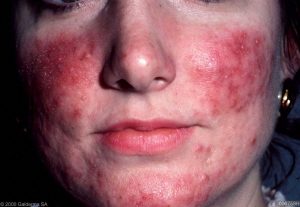
Rosacea can exacerbate causing inflamed spots.
How do we treat rosacea?
At Elan Medical Skin Clinic we treat rosacea with prescription only medications and phototherapy.
- Oral medication is prescribed to reduce the inflammation in the skin.
- Topical medication is prescribed to keep the Demodex folliculorum mite off of the face at night. We no longer recommend topical antibiotic creams such like Metronidazole Gel, as rosacea is not a bacterial infection.
- In severe or resistant cases, stronger oral and topical medication is required.
- Rosacea Phototherapy can be a useful adjunct to medical treatment as it reduces the inflammatory lesions.
- Lasers can be used to reduce the appearance of telangectasias (dilated blood vessels) and thickening of the skin.
Click here to read what our patients are currently saying about Elan Medical Skin Clinic.
Can the weather affect rosacea?
Sun exposure, hot weather, humidity, cold and wind have all been known to aggravate rosacea for many individuals. The following are defense strategies you can use:
- Always protect your face from the sun. Wear a sunscreen with an SPF (sun-protection factor) of 15 or higher year round. If necessary, use a formulation developed for children to avoid irritation. Wear a broad-brimmed hat. Minimize midday (10 a.m. to 2 p.m.) exposure to the sun during summer months.
- Stay in a cool, air-conditioned environment on hot, humid days. If this is impossible, those affected should sip cold drinks and try not to overexert themselves. If necessary, chew on ice chips to lower facial temperature or spray the face with cool water.
- Combat cold by covering your cheeks and nose with a scarf. In winter, rosacea sufferers also may don a ski mask when participating in outdoor sports or activities, as well as cover up on windy days. If these conditions aggravate your rosacea, limiting your time outdoors in cold weather may also help.
- Use a moisturizer daily during cold weather. This protects against the naturally drying effects of cold and wind.
Can stress aggravate rosacea?
Stress ranks high on the list of tripwires for many rosacea sufferers. However, in a survey of rosacea patients affected by stress, most of those using stress management techniques said they had successfully reduced their flare-ups. When feeling overwhelmed, try some of the following stress reducers:
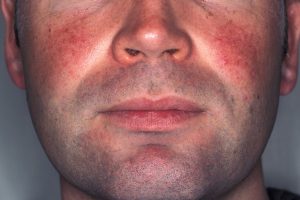
Men can get rosacea too and it can get worse very quickly in men
- Take care of your whole self. Eat healthy, exercise moderately and get the right amount of sleep. It may also help to cut down on caffeine.
- When under stress, try deep-breathing exercises. Inhale and count to 10, then exhale and count to 10. Repeat this exercise several times.
- Use visualization techniques. Sit in a quiet place, close your eyes and visualize a beautiful vacation spot or favourite pleasurable activity or painting to reduce stress. Hold the image for several minutes to feel its peacefulness and beauty.
- Stretch out and relax all your muscles. Relax muscles starting at the top of the head and work down to the toes for a whole-body stress reliever.
Can foods and beverages affect rosacea?
Steaming hot soup or coffee, spicy nachos, a glass of wine — no matter how appetizing they sound, these foods and beverages may be a problem for some rosacea sufferers. Hot liquids may cause flushing. Spicy foods like oriental mustard sauce or salsa can raise a sweat, and alcoholic beverages may trigger flare-ups in many cases. These tips will help you select rosacea-friendly meals:
- Monitor how your rosacea reacts to alcoholic beverages. Alcoholic beverages often induce flare-ups in rosacea sufferers. If alcohol aggravates your condition, reduce your intake or avoid alcohol entirely.
- Avoid “hot” spices such as white and black pepper, paprika, red pepper and cayenne, which are common rosacea tripwires.
Can exercise make my rosacea worse?
While exercise may be part of a healthy lifestyle, it could actually be harmful to rosacea sufferers if it causes their condition to flare up. Moderation is the key. And even then, take these precautions:
- Avoid heavy exertion or high-intensity workouts that cause overheating and bring on flushing. Replace them with low-intensity exercise routines, which often can be just as effective.
- Try exercising for shorter, more frequent intervals. For instance, exercise for 15 minutes three times a day, rather than exercising all at once.
- When exercising outdoors during warm weather, choose early morning or early evening hours when it’s cooler. No matter what time of day, protect your face from the sun and avoid hot weather exercise.
- When exercising indoors, make sure the room is well ventilated. Run a fan, open the window for a breeze or turn on the air conditioning to avoid overheating.
- Try to stay as cool as possible when exercising. Drape a cool, damp towel around your neck, drink cold fluids or chew on ice chips. You can also keep a bottle filled with cool water to spray your face.
Bathing and cleansing can also cause flare-ups
Rosacea sufferers often must modify their approach to cleansing and bathing. The following tips can help you adopt a personal-care routine that soothes and calms your facial redness:
- Avoid hot water, hot tubs and saunas. These can bring on flushing and aggravate your condition.
- Begin each day with a thorough and gentle facial cleansing. Use a gentle cleanser that is not grainy or abrasive and spread it with your fingertips. Rinse your face with lukewarm water to remove all dirt and soap, and use a thick cotton towel to gently blot the face dry.
- Never pull, tug, scratch or treat your face harshly. Avoid any rough washcloths, loofahs, brushes or sponges.
- Let your face thoroughly air dry before applying any medication or skin-care products. Let your face rest for a few minutes before applying topical medication. Then allow the medication to dry completely for five to 10 minutes before applying any moisturizer or makeup.
- Men should use an electric shaver rather than a blade. If a blade is preferred, never use a dull blade that requires extra scraping for a clean shave. Avoid shaving lotions that burn or sting.
- Repeat the cleansing process at night. Gently cleanse your face each night to remove any makeup or dirt accumulated throughout the day. Air dry and apply your topical medication.
Choose your skin-care products carefully
Rosacea sufferers can use a variety of skin-care products to their advantage. Moisturizers can reduce flakiness and makeups can camouflage symptoms and improve appearance. You may have to experiment until you find the products that work best for your individual condition. Here are some general guidelines that will help you select products carefully:
- Steer clear of ingredients that sting, burn or cause facial redness. Some ingredients to avoid include alcohol, witch hazel, menthol, peppermint, eucalyptus oil or clove oil.
- Select fragrance-free products. If you must choose a product that contains a fragrance, be sure that it appears at the end of the list of ingredients. The further down it appears, the less fragrance the product contains.
- Use makeup to hide blemishes and cover redness. Spot application of makeup may be used to cover blemishes and visible blood vessels, and green-tinted foundations are available at most cosmetic counters to mask general redness. They can be followed by a skin-tone foundation. Avoid powders, which can make dry flaky skin look worse.
Other medical conditions can make rosacea worse
Physicians have found that some underlying health conditions and temporary ailments can stimulate a flushing response and trigger rosacea flare-ups. The following conditions should be ruled out or treated by your doctor as appropriate to help bring flare-ups under control:
- Hot flashes associated with menopause. The hot flashes that often occur before or during menopause have brought on rosacea’s first appearance in some women.
- Fevers, coughs and colds. Although intermittent, these ills may provoke the flushing that begins a rosacea flare-up.
- Systemic diseases. Occasionally systemic diseases, such as high blood pressure, have been identified as causes of rosacea flare-ups. When flushing is accompanied by itching, breathing difficulties or diarrhoea, seek medical attention.
Certain medications can worsen rosacea
Certain drugs can cause facial flushing, resulting in rosacea flare-ups. If you experience flare-ups as a result of the following drugs, discuss the problem with your doctor:
- Vasodilator drugs. These drugs are used in the treatment of cardiovascular disease because of their ability to dilate the blood vessels. In some patients, they have been reported to cause symptoms called “vasodilator rosacea.”
- Topical steroids. Long-term use of topical steroids has been found to aggravate rosacea or induce rosacea-like symptoms. In one study, symptoms improved for patients who discontinued the steroids and were prescribed antibiotics.
The post Rosacea Update – New Treatments Available appeared first on Elan Medical Skin Clinic LTD.
]]>



